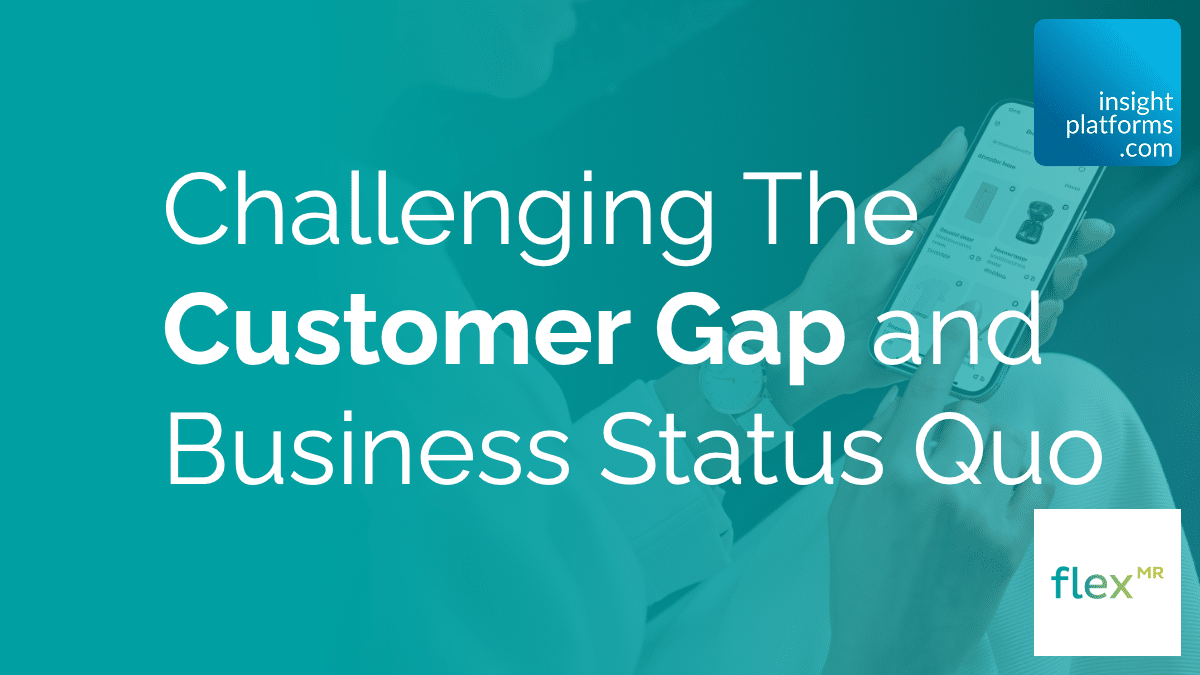
Challenging The Customer Gap and Business Status Quo
By FlexMR
- article
Why do any significant moves towards closing the Customer Gap seem to fail, when ‘customer needs’ is one of the four stated pillars of marketing and when insight, marketing and analytics professionals also believe that businesses should focus on customers?
Some rudimentary research using Google Scholar suggests one possible reason: there is over four times the level of interest in understanding how consumers make decisions than there is in understanding how businesses make them. The graph of the data collected for this statistic provides a striking visual of just how large a gap this truly is.
Stay up to date
Subscribe to receive the Research Tools Radar and essential email updates from Insight Platforms.
Your email subscriptions are subject to the Insight Platforms Site Terms and Privacy Policy.

This struck a chord because all the discussions I have seen throughout my academic and business career have focussed solely on furthering the understanding of consumer behaviour, not organisational decision-making.
Understanding The Customer Gap
Consumers and businesses are both complex but whilst there has been considerable effort to understand the differing roles of rational and irrational purchase intent, there has been very little study or understanding of the complexity of business decisions.
The reality is that businesses are human systems, and decision-making is never linear or straightforward. That creates a problem, because if we do great research into what our customers want but don’t understand how that insight is used, then it may never inform the decisions it was intended for.
Unless we can truly understand how businesses harness customer data in their decision-making, it is likely that most organisations will make sub-optimal decisions, create inefficiency and not succeed in orientating themselves to be truly focussed on their customers.
Forrester’s data alludes to this situation being a reality in most organisations: with just less than half of senior executives (48%) saying they use data in their decision-making. And therein lies the start of understanding why the Customer Gap exists, and why the aspirations of CMOs to be customer-centric are destined to always remain an aspiration unless something changes.
The Need for Networking Data and Insights
This is a challenge for technology and SaaS firms in the Martech and Restech industries because their aim is to empower us with more data and tools to execute more efficient and effective marketing strategies. Yet whilst it might be more efficient, it isn’t likely to reduce The Customer Gap nor better orientate an organisation to its customers and market.
Creating informed decisions is not necessarily one of data availability, access, or technology. The problem was never the lack of data.
Using technology to ‘democratise’ data has the advantage that anybody can access data or run data collection themselves. Whilst this creates more efficient data processes and improved data intelligence, without a clear understanding of how businesses make use of that data in their decision-making, it is likely to remain less than effective.
The answer is that data and insights need to be more ‘networked’. The problem tends to be that decision-makers operate in silos, and linear hierarchies and tend to be more concerned with their specific task orientation than they are with the wider organisation, teams and data sources.
Move away from only using data in a task-orientated way
The majority of managers tend to operate the majority of their time in a functional ‘task-orientated’ way. This is natural and required for people to take action and complete projects. However, where managers are only preoccupied with their own tasks they stop being able to see the wider needs of the organisation and other stakeholders. They also stop being able to see data sources that lie outside of their normal task view. These, then, constrain their ability to make sense of data when it is available and could lead to data being missed completely.
Develop a wider perspective of ‘multi-lateral exchange’
Another challenge that organisations face is hierarchical structures, which makes it easier for communications to move up and downwards, but never across.
Teams must find new ways to surface and exchange data between teams and across departmental barriers. For example, insights that exist within Customer Services might change the perspective of a Marketing or Product Manager within another department.
Creating processes for improving the multi-lateral exchange is imperative. However, be aware that whilst putting in new knowledge management systems may seem a logical answer, just having access to more data doesn’t in itself guarantee more use and success.
Increasing collaboration within business networks to improve sense-making
Data silos, divisional hierarchies, and our task orientation all make collaboration difficult, which means that ‘sense-making’ often doesn’t happen effectively. Sense-making is a critical step in any decision process, yet it is one that is rarely covered in our minimal understanding of business decision-making.
This isn’t just making data systems available to everyone in a more democratised way, it is also about aiding the process of making sense of it and sharing understanding about its meaning; knowledge rather than information is required. This requires finding new behaviours – not just systems – to encourage greater active collaboration.
Challenging the Customer Status Quo
The challenge is for organisations to better understand how they make decisions and how they make use of the data and insights available to them. As the Forrester statistic shows, solely promoting data access doesn’t necessarily lead to better and more informed decisions.
Organisations need to do more to reduce task orientation, increase multi-lateral exchange, and improve collaboration, all with the aim of improving sense-making so that customers are brought to mind more effectively at the points when decisions are made.
Challenging the way we use technology and moving beyond it to understand the way it is used, the behaviours around it, and the culture that it leads to is just – if not more – important. The Customer Salience Toolkit helps us think about how we do this by Creating improved insight programmes, Connecting stakeholders better with data and customers, and increasing Collaboration so that we rely less on the technology alone.


